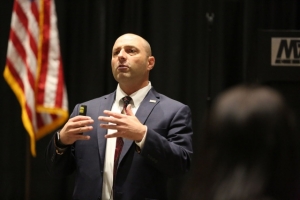School, public safety receive active shooter training
By Sierra Henry
Published in News on July 20, 2018 5:50 AM

News-Argus/CASEY MOZINGO
Mike Clumpner, Threat Suppression chief executive officer, speaks to more than 300 people Thursday during a daylong Crisis Preparedness, Response and Communications Symposium at the Maxwell Center.
Education prevents shootings -- that is the reason R.J. Allen, a Charles B. Aycock High School teacher, attended the Crisis Preparedness, Response and Communications Symposium Thursday morning.
Close to 350 school teachers, law enforcement agents and emergency first responders attended the symposium at the Maxwell Regional Agriculture and Convention Center. The symposium provided details on how to respond if an active shooter targets a school campus. Those in attendance learned how to recognize warning signs in a child or teen who may become violent. They also learned how to potentially prevent a school shooting and how to respond in a moment of crisis.
"Being able to come here and try to stop them, knowing what I can do as a teacher in the classroom to educate my student and then take what I know and go back and educate other teachers as well (on) what we can do to decrease school shootings (is important) ...," Allen said. "We want to make our kids safe, that's the number one priority. We want parents to feel that their kids are safe at school.
"I do this job because I love what I do, and I love the kids. So, you're going to do whatever you have to as a teacher to protect your students, and this is part of the process."
Symposium speakers included Mike Clumpner, president and chief executive officer of Threat Suppression, a public safety training firm, and Joseph Erardi, retired superintendent of Newton Connecticut Schools.
Clumpner, who received a doctorate in homeland security leadership and policy from North Central University, focused on the history of adolescent school shooters and how to recognize the signs of when a student might turn toward an act of violence. He said there is no standard profile for school shooters, but there are some common denominators case-by-case, including suicidal intentions and depression.
"Anger turned inside is suicide," he said. "Anger turned outside is homicide. We look for someone who is depressed . . . What ends up happening is, we see depression, we see mental illness, and we see . . . (that) they want to express their feelings and, unfortunately, what happens is their feelings culminate together into this volcano of rage that's coming out, and when that happens sometimes it's mass violence."
Clumpner also touched on another warning sign that some students exhibit, which he called threat leakage -- when students "leak" signs that they are going to possibly commit an attack. He specifically focused on how to pick up on those signs and what people can do to intervene.
In cases where someone thinks there might be a possible attack or if someone is showing signs of attacking, Clumpner urges people to contact 911, school officials and public safety personnel.
"It's just like (the Department of Homeland Security) says -- if you see something, say something," he said. "Unfortunately, we know in 80 percent of school shooter attacks, at least one non-involved person knew and they didn't tell anyone, and in 66 percent of attacks, multiple people knew.
"Tell your kids, if you think something is going on at school, if you think that someone is possibly planning an attack, please let us know so we can investigate it and intervene and get help where it's needed."
In the wake of school shootings, such as the ones in Newtown, Connecticut, and Parkland, Florida, Clumpner said the phrases, "I didn't think this would happen here," and "I moved to a rural community because I didn't want this to happen," pop up. He stressed that shootings don't just take place in cities. They can also happen in rural areas. According to Clumpner, 98 percent of school shootings happen in communities that are served by 100 or fewer police officers.
This is why it is important for schools and communities to be prepared, he said.
"What we find in all the after-action reports is the failure to plan and prepare keeps you going down the same path of mistakes," he said.
Tara Humphries, Wayne Community College public information officer, remembers the college campus shooting in April of 2015 in which Ron Lane, a print shop technician, was killed. The shooting happened only months after an active shooter symposium was held by the college. Humphries said she believes preparing for possible shootings is important.
"The more you think through these things, work through these things, the more it becomes muscle memory (on) how to react, how to respond, the better we will respond if anything should happen, and we know that it can," Humphries said.
The symposium included representatives from every public school in Wayne County, along with some private schools, Wayne Community College and 26 representatives from institutes of higher education, Humphries said. Fire department, law enforcement and Air Force personnel also attended, as well as nonprofit partners, such as Partnership for Children. Teachers and law enforcement from as far as Transylvania County and Charlotte were also in attendance.
The symposium was sponsored by Wayne County Public Schools in partnership with Wayne UNC Health Care.
